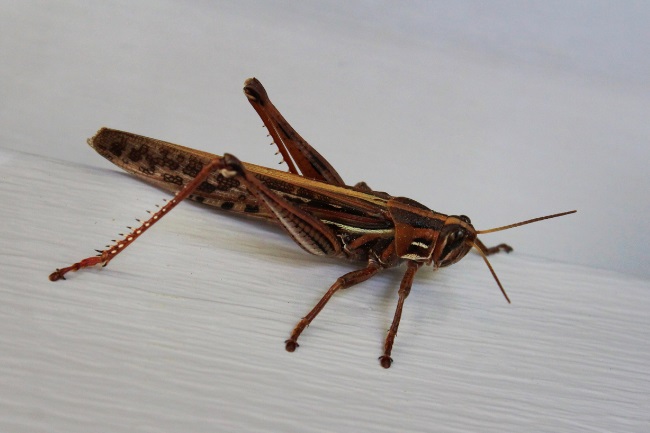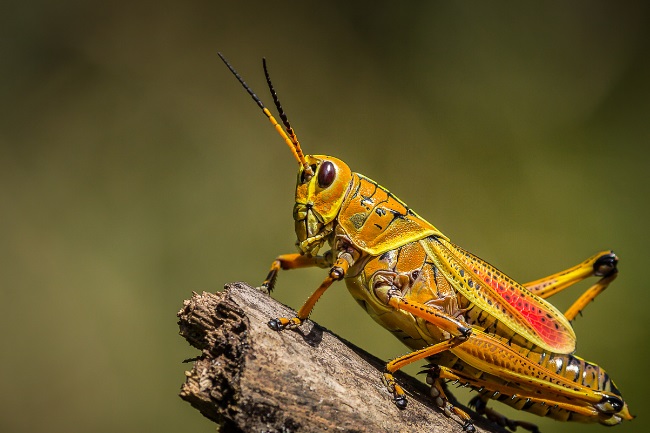How high or far a grasshopper can jump depends a great deal on its size. It also depends in part on what it is trying to get away from and whether it prefers to hop, fly or walk. As a rule of thumb, grasshoppers can jump 20 times their own length.
Contents
How do grasshoppers jump?
Like all insects, grasshoppers have six legs. These are made up, or four small legs are the front of its body and two large legs at the back. It’s these larger legs that provide the power for the jump.
In order to get the most out of their energy, the grasshopper takes up a squatting position, with the femurs (thighs) pressed against the tibiae (shins). The mechanics of the grasshopper’s knee acts like a spring, storing up energy until a nerve pulse tells it to release.

This release is like a catapult going off or a bow letting go of an arrow. The nerve impulses sent down to the legs decide whether the grasshopper does a small, medium or high hop. How far a grasshopper jumps depends largely on what it is trying to get to, or away from.
Also read: Do Grasshopper Eat Grass? Or Something Else?
Why do grasshoppers jump?
Jumping for grasshoppers is both a handy way to get around and an essential emergency escape strategy. Though many grasshopper species can fly, they will often choose to hop instead, perhaps because of the additional burst of speed. For those grasshoppers who can’t, or choose not to, fly, such as many lubber grasshoppers, locomotion by hopping is even more critical.
How high can a grasshopper jump?
Grasshoppers use their impressive leg muscles to propel themselves at a rate of 10 feet per second.
Different species can jump to different heights, but a rule of thumb is generally thought to be that a species can jump 20 times its length in height.
The equivalent for a human would be hopping casually over a five-storey building.
How far can a grasshopper jump?
How far a grasshopper can jump is again dependant on its size, but some species are known to jump as far as 1.25m (49.21 in). This would be the equivalent of a human jumping the length of a football pitch.
Who jumps best?

Because of human bias, we often think of the males of animals being stronger than the females; however, in many species, the females are actually significantly stronger and larger. In grasshoppers, the female tends to be larger than the male. This is because she is the one who has to put her energy into egg making. Because she is bigger, she also has larger legs, which means that female grasshoppers can generally hop further and higher than the males.
The largest grasshopper in the world is often quoted to be the giant grasshopper, which is 12cm (4.72 in) in length. Theoretically, this grasshopper should be able to jump 2.4m (94.5 in), though its large wingspan, around 23cm (9.06 in), suggests it may prefer to fly.
Are they jumping kings?
We might think of grasshoppers as being the ultimate insect jumpers, but they pale in comparison to some other notable jumpers. Froghoppers are best known for their larval stage when they produce a thick spit-like substance to hide and protect their bodies. These tiny insects can jump an impressive 70 times their length.
Jumping spiders, though not an insect, are another impressive set of arthropods. These tiny spiders are ambush hunters rather than web weavers. Able to jump approximately 100 lengths, it’s a good thing they aren’t the size of tarantulas.
Yet, grasshoppers can still be excellent hoppers. There are few studies on the jumping distances or heights of different species, but we can work out rough distances by the length of the grasshopper.
American bird grasshopper

Often referred to as a locust due to its voracious appetite and tendency to turn up in larger numbers, the American bird grasshopper is between 4.5 (17.72 in) and 5.5cm (2.17 in) in length. For a larger specimen, it would therefore be able to jump to a height of 1.1m (43.31 in). However, as one of the bird grasshoppers, it’s more a fan of flying and can get high up into the sky as it searches for new feeding grounds.
Crau grasshopper

This Mediterranean species is endangered across much of its range due to habitat degradation. Around 3-4.5cm (1.18-1.77 in) in size it is wingless meaning jumping is an important escape mechanism. It should be able to jump 90cm (35.43 in).
Plains lubber grasshopper

The plains lubber grasshopper is a similar size to the American bird grasshopper, though much sturdier-looking. However, some reports have recorded that males can jump an impressive 2.7m (106.3 in). This is surprising when lubber grasshoppers have a reputation for being lazy.
Feeling a little jumpy?
Hopping, or jumping, is an important tool to most grasshoppers. If you want to find out how effective it is all you need to do is go out and try to catch a grasshopper in your hands. It’s certainly not easy.
Whether they are trying to escape, reach a tasty snack, or just hopping around, grasshoppers certainly are impressive jumpers.

